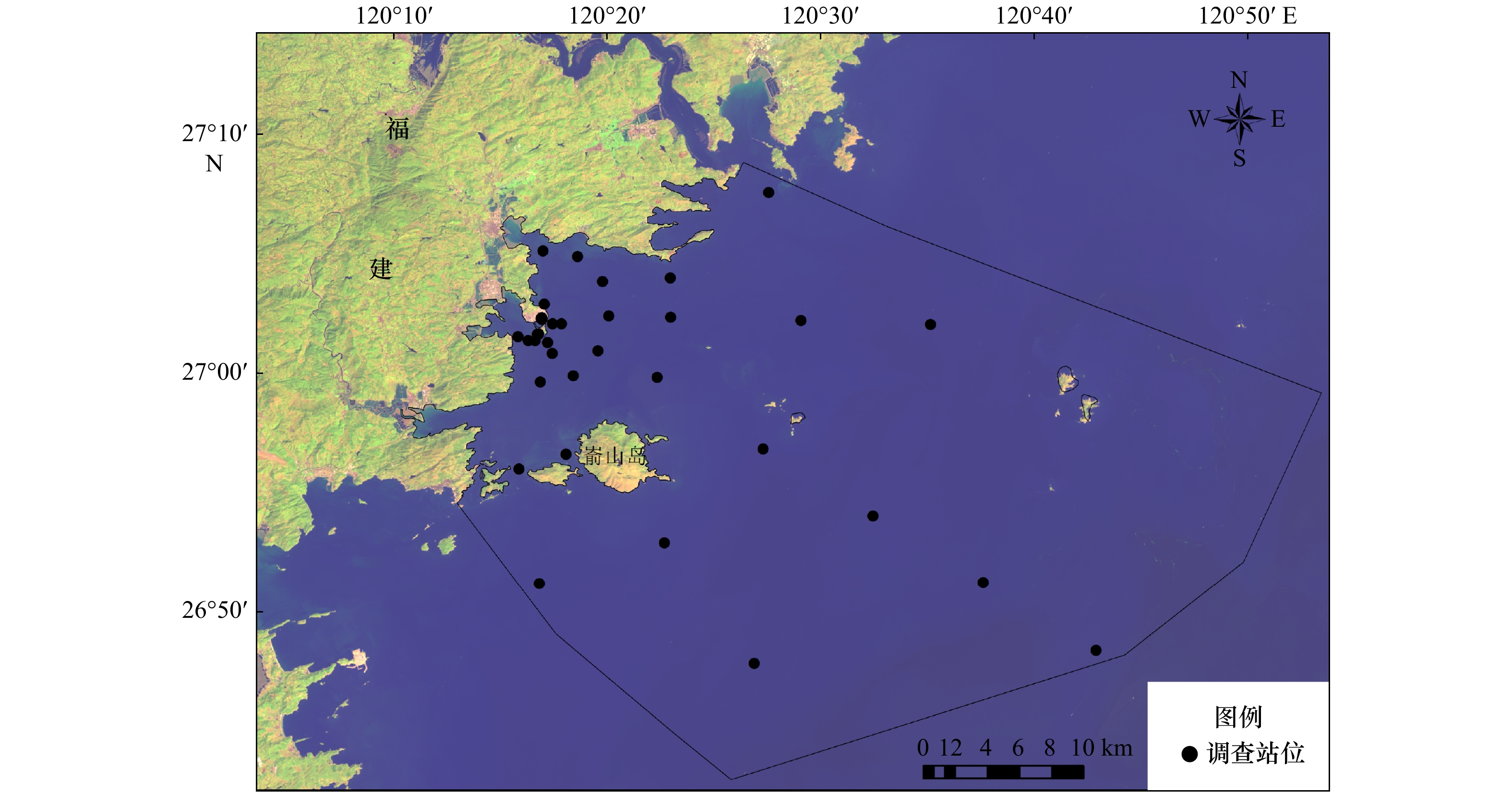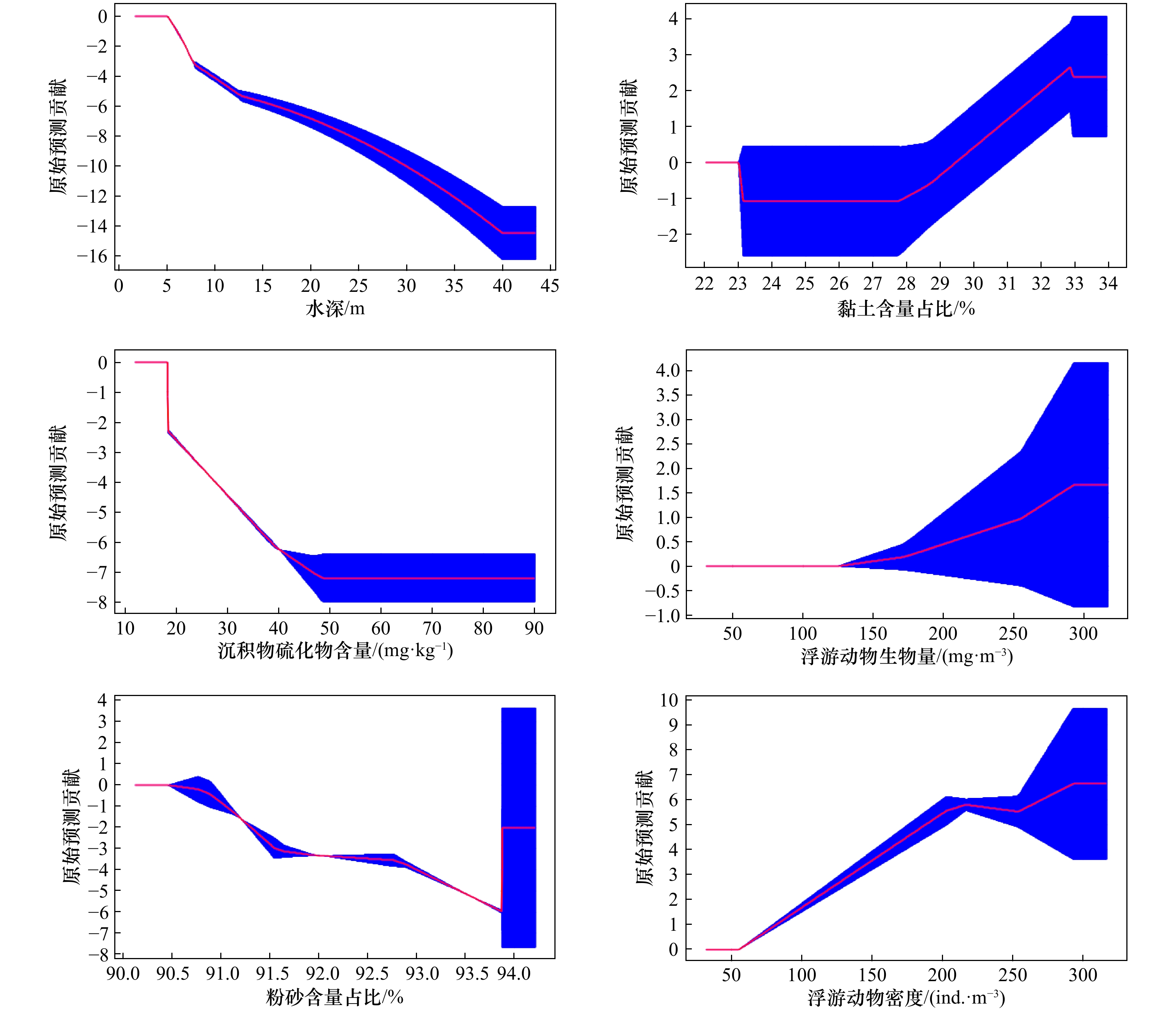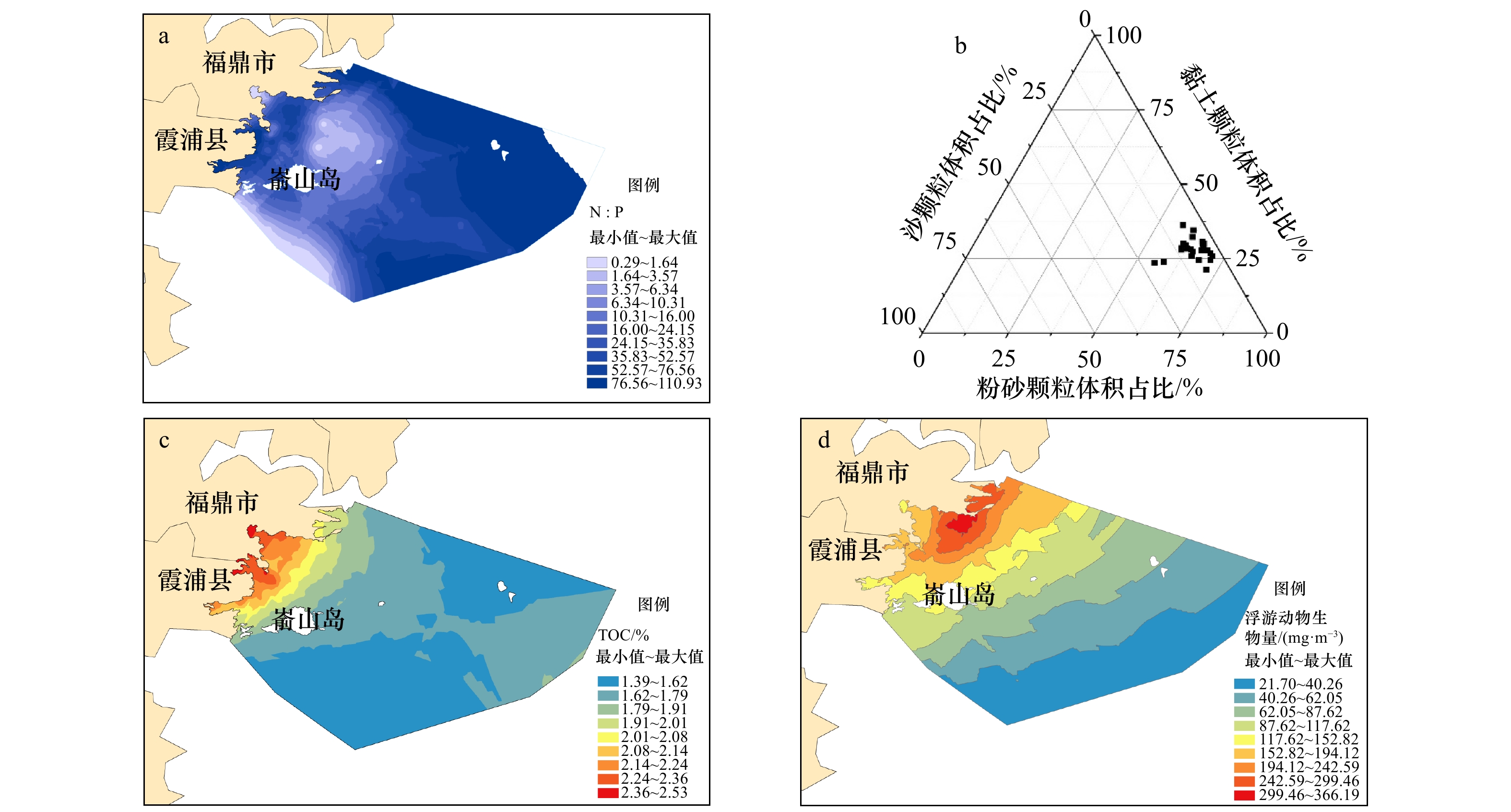The potential suitability habitat prediction of Acaudina molpadioides based on Maxent model
-
摘要: 生境适宜性预测对物种保护、外来生物及有害生物防治具有重要指导意义。本研究应用Maxent模型对宁德晴川湾海域海地瓜适宜性生境进行预测,模型的预测结果达到优秀水平,并结合ArcGIS软件对海地瓜适宜生境划分为5级。研究结果表明,极高和较高海地瓜适宜生境占总研究区域的1.3%,面积为25.6 km2。水体环境、沉积环境和生态群落均对海地瓜分布产生影响,水体环境中水深、盐度、无机氮和活性磷酸盐是影响海地瓜生境适宜性的主要水环境因子,对海地瓜适宜生境预测累计贡献率达39%,尤其水深是制约海地瓜分布最为主要的因子,预测贡献率为27%;沉积物粒度、硫化物和总有机碳是沉积环境主要影响因子,预测累计贡献率达40.4%,其中沉积物黏土颗粒体积占比是第二重要影响因子,预测贡献率约为18%。浮游动物密度和生物量以及底栖动物种类数量均对海地瓜分布产生一定影响,三者预测累计贡献率为16.8%,其中浮游动物密度的贡献相比其他生物要素最为重要,贡献率约为8%。总体上,海地瓜最为理想的分布区是近岸水深小于5 m、盐度相对较低、沉积物有机碳含量较高、底质为黏土−粉砂土为主的浅水淤泥质生境。Abstract: The prediction of habitat suitability has important guiding significance for species protection, alien and pest control. In this study, Maxent model was used to predict the suitability habitat of A. molpadioides in Qingchuan Bay, Ningde, Fujian Province. The results of the model reached an excellent level. Combined with ArcGIS software, the suitable habitat of the A. molpadioides was divided into five grades. The results showed that: 1.3% of the total study area was highly suitable, and the area was 25.6 km2. Water environment, sedimentary environment and ecological community all had an impact on the distribution of the A. molpadioides. Water depth, salinity, inorganic nitrogen and active phosphate were the main factors of water environment. The cumulative contribution rate to the prediction of the suitable habitat of A. molpadioides was 39%, especially, the water depth was the most important factor that restricts the distribution of the A. molpadioides, the prediction contribution rate was 27%; sediment grain size, sulfide content and total organic carbon in surface sediment were the main factors of sedimentary environment, and the cumulative contribution rate was 40.4%. The second important factor was the volume percentage of substrate of sediment clay, and the contribution rate was about 18%. The density and biomass of zooplankton and the number of benthos all had a certain impact on the distribution of A. molpadioides, the cumulative contribution rate was 16.8%, among which the contribution rate of zooplankton density to other biological factors was the most important, about 8%. On the whole, the most ideal distribution area of A. molpadioides is the shallow water muddy bottom habitat, where the water depth is less than 5 m, the salinity is relatively low, the organic carbon content of sediment is relatively high, and the bottom material is mainly clay silt.
-
Key words:
- Maxent model /
- Acaudina molpadioides /
- habitat /
- potential distribution prediction
1) 国家核安全局关于近期海洋生物或异物影响核电厂取水安全事件的通报。 -
表 1 海地瓜生境适宜性分布预测应用的生态环境变量
Tab. 1 The ecological environment variables used to predict the potential habitat of the Acaudina molpadioides
环境变量 环境要素 单位 代号 水体环境 温度 ℃ t 盐度 s 水深 m deep pH pH 悬浮物浓度 mg/L Sed. 浑浊度 NTU NTU 化学需要量 mg/L COD 溶解氧 mg/L DO 生化需氧量 mg/L BOD 叶绿素 a mg/L Chl a 总碳 mg/L TC 总氮 mg/L TN 总磷 mg/L TP 无机氮 mg/L N 活性磷酸盐 mg/L P 活性硅酸盐 mg/L Si 生物种类构成及特征 浮游植物多样性 PH 浮游植物密度 ind./L Pdens 浮游植物种类数 N PSN 浮游动物多样性 ZH 浮游动物密度 ind./m3 Zdens 浮游动物种类数 N ZSN 浮游动物生物量 mg/m3 zbio 底栖生物多样性 Benh 底栖动物种类数 N BSN 底栖生物生物量 g/m2 BBIO 沉积环境 沉积物硫化物 mg/kg NS1 沉积物含水率 % WC 有机碳 % TOC 黏土质粉砂 % CC 粉砂 % SC 沙 % Sand 表 2 各环境变量贡献率
Tab. 2 Contribution percent of each environmental factor in MaxEnt modeling
环境变量 贡献率/% 水深 27 黏土颗粒体积占比 17.6 沉积物硫化物含量 14.3 浮游动物密度 8.3 粉砂颗粒体积占比 6.2 活性磷酸盐 6 浮游动物生物量 5.9 无机氮 3 海水盐度 3 底栖生物种类数 2.6 沉积物总有机碳 2.3 底栖生物多样性指数 1.1 表 3 分布区等级及分布面积占比
Tab. 3 distribution grade and the percentage of distribution area
潜在分布区等级 分布预测概率/% 栅格数 面积/km2 占比/% 极高适宜分布区 >95 190 5.9 0.3 较高适宜分布区 80~95 619 19.7 1 中度适宜分布区 60~80 1 400 43.4 2.2 较低适宜分布区 40~60 3 331 108.5 5.5 极低适宜分布区 <40 54 686 1795.5 91 -
[1] 王金亮, 陈姚. 3S技术在野生动物生境研究中的应用[J]. 地理与地理信息科学, 2004, 20(6): 44−77. doi: 10.3969/j.issn.1672-0504.2004.06.010Wang Jinliang, Chen Yao. Applications of 3S technology in wildlife habitat researches[J]. Geography and Geo-Information Science, 2004, 20(6): 44−77. doi: 10.3969/j.issn.1672-0504.2004.06.010 [2] 刘振生, 高惠, 滕丽微, 等. 基于MAXENT模型的贺兰山岩羊生境适宜性评价[J]. 生态学报, 2013, 33(22): 7243−7249.Liu Zhensheng, Gao Hui, Teng Liwei, et al. Habitat suitability assessment of blue sheep in Helan Mountain based on MAXENT modeling[J]. Acta Ecologica Sinica, 2013, 33(22): 7243−7249. [3] Drake J A. Community-assembly mechanics and the structure of an experimental species ensemble[J]. The American Naturalist, 1991, 137(1): 1−26. [4] Chase J M. Community assembly: when should history matter?[J]. Oecologia, 2003, 136(4): 489−498. [5] Thuiller W, Richardson D M, Pyšek P, et al. Niche-based modelling as a tool for predicting the risk of alien plant invasions at a global scale[J]. Global Change Biology, 2005, 11: 2234−2250. [6] Phillips S J, Dudik M. Modeling of species distributions with Maxent: new extensions and a comprehensive evaluation[J]. Ecography, 2008, 31: 161−175. [7] 乔慧捷, 胡军华, 黄继红. 生态位模型的理论基础、发展方向与挑战[J]. 中国科学: 生命科学, 2013, 43(11): 915−927.Qiao Huijie, Hu Junhua, Huang Jihong. Theoretical basis, future directions, and challenges for ecological niche models[J]. Scientia Sinica Vitae, 2013, 43(11): 915−927. [8] 张琴, 张东方, 吴明丽, 等. 基于生态位模型预测天麻全球潜在适生区[J]. 植物生态学报, 2017, 41(7): 770−778. doi: 10.17521/cjpe.2016.0380Zhang Qin, Zhang Dongfang, Wu Mingli, et al. Predicting the global areas for potential distribution of Gastrodia elata based on ecological niche models[J]. Chinese Journal of Plant Ecology, 2017, 41(7): 770−778. doi: 10.17521/cjpe.2016.0380 [9] Phillips S J, Anderson R P, Schapire R E. Maximum entropy modeling of species geographic distributions[J]. Ecological Modelling, 2006, 190: 231−259. [10] 邢丁亮, 郝占庆. 最大熵原理及其在生态学研究中的应用[J]. 生物多样性, 2011, 19(3): 295−302.Xing Dingliang, Hao Zhanqing. The principle of maximum entropy and its applications in ecology[J]. Biodiversity Science, 2011, 19(3): 295−302. [11] 马松梅, 张明理, 张宏祥, 等. 利用最大熵模型和规则集遗传算法模型预测孑遗植物裸果木的潜在地理分布及格局[J]. 植物生态学报, 2010, 34(11): 1327−1335. doi: 10.3773/j.issn.1005-264x.2010.11.010Ma Songmei, Zhang Mingli, Zhang Hongxiang, et al. Predicting potential geographical distributions and patterns of the relic plant Gymnocarpos przewalskii using maximum entropy and genetic algorithm for rule-set prediction[J]. Chinese Journal of Plant Ecology, 2010, 34(11): 1327−1335. doi: 10.3773/j.issn.1005-264x.2010.11.010 [12] 郝朝运, 谭乐和, 范睿, 等. 利用最大熵模型预测药用植物海南药的潜在地理布局[J]. 热带作物学报, 2011, 32(8): 1561−1566. doi: 10.3969/j.issn.1000-2561.2011.08.037Hao Chaoyun, Tan Lehe, Fan Rui, et al. Predicting potential geographical distributions of medicinal plant Piper hainanense using maximum entropy[J]. Chinese Journal of Tropical Crops, 2011, 32(8): 1561−1566. doi: 10.3969/j.issn.1000-2561.2011.08.037 [13] Roberto M, Zamora R, Molina J R, et al. Predictive modeling of microhabitats for endemic birds in south Chilean temperate forests using maximum entropy (Maxent)[J]. Ecological Informatics, 2011, 6: 364−370. [14] 颜文博, 王琦, 王超. 应用Maxent模型分析秦巴地区朱鹮适宜繁殖地的分布[J]. 动物学杂志, 2015, 50(2): 185−193.Yan Wenbo, Wang Qi, Wang Chao. Evaluation of potential breeding habitat distribution with Maxent model for crested ibis in the Qinling-Bashan region[J]. Chinese Journal of Zoology, 2015, 50(2): 185−193. [15] 朱明畅, 曹铭昌, 汪正祥, 等. 黄河三角洲自然保护区水禽生境适宜性模糊综合评价[J]. 华中师范大学学报(自然科学版), 2015, 49(2): 287−294, 301.Zhu Mingchang, Cao Mingchang, Wang Zhengxiang, et al. Fuzzy evaluation of waterfowl habitat suitability at the Yellow River delta nature reserve[J]. Journal of Huazhong Normal University (Natural Sciences), 2015, 49(2): 287−294, 301. [16] 曹铭昌, 孙孝平, 乐志芳, 等. 基于Maxent模型的丹顶鹤越冬生境变化分析: 以盐城保护区为例[J]. 生态与农村环境学报, 2016, 32(6): 964−970. doi: 10.11934/j.issn.1673-4831.2016.06.015Cao Mingchang, Sun Xiaoping, Le Zhifang, et al. Analysis of changes in wintering habitat of red-crowned cranes based on Maxent model: A case study of Yancheng nature reserve[J]. Journal of Ecology and Rural Environment, 2016, 32(6): 964−970. doi: 10.11934/j.issn.1673-4831.2016.06.015 [17] 李丽鹤, 刘会玉, 林振山, 等. 基于Maxent和Zonation的加拿大一枝黄花入侵重点监控区确定[J]. 生态学报, 2017, 37(9): 3124−3132.Li Lihe, Liu Huiyu, Lin Zhenshan, et al. Identifying priority areas for monitoring the invasion of Solidago canadensis based on Maxent and Zonation[J]. Acta Ecologica Sinica, 2017, 37(9): 3124−3132. [18] 张熙骜, 隋晓云, 吕植, 等. 基于Maxent的两种入侵性鱼类(麦穗鱼和鲫)的全球适生区预测[J]. 生物多样性, 2014, 22(2): 182−188.Zhang Xi’ao, Sui Xiaoyun, Lü Zhi, et al. A prediction of the global habitat of two invasive fishes (Pseudorasbora parva and Carassius auratus) from East Asia using Maxent[J]. Biodiversity Science, 2014, 22(2): 182−188. [19] 车乐, 曹博, 白成科, 等. 基于MaxEnt和ArcGIS对太白米的潜在分布预测及适宜性评价[J]. 生态学杂志, 2014, 33(6): 1623−1628.Chen Le, Cao Bo, Bai Chengke, et al. Predictive distribution and habitat suitability assessment of Notholirion bulbuliferum based on MaxEnt and ArcGIS[J]. Chinese Journal of Ecology, 2014, 33(6): 1623−1628. [20] 刘想, 龚熹, 陈思斯, 等. 基于Maxent和ArcGIS模拟檫木分布格局及其栖息地的变化[J]. 植物科学学报, 2018, 36(3): 320−326. doi: 10.11913/PSJ.2095-0837.2018.30320Liu Xiang, Gong Xi, Chen Sisi, et al. Simulation of the distribution pattern of Sassafras tzumu and changes in habitat based on ArcGIS and Maxent[J]. Plant Science Journal, 2018, 36(3): 320−326. doi: 10.11913/PSJ.2095-0837.2018.30320 [21] 刘清亮, 李垚, 方升佐. 基于MaxEnt模型的青钱柳潜在适宜栽培区预测[J]. 南京林业大学学报(自然科学版), 2017, 41(4): 25−29.Liu Qingliang, Li Yao, Fang Shengzuo. MaxEnt model-based identification of potential Cyclocarya paliurus cultivation regions[J]. Journal of Nanjing Forestry University (Natural Science Edition), 2017, 41(4): 25−29. [22] 徐军, 曹博, 白成科. 基于MaxEnt濒危植物独叶草的中国潜在适生分布区预测[J]. 生态学杂志, 2015, 34(12): 3354−3359.Xu Jun, Cao Bo, Bai Chengke. Prediction of potential suitable distribution of endangered plant Kingdonia uniflora in China with MaxEnt[J]. Chinese Journal of Ecology, 2015, 34(12): 3354−3359. [23] 齐增湘, 徐卫华, 熊兴耀, 等. 基于MAXENT模型的秦岭山系黑熊潜在生境评价[J]. 生物多样性, 2011, 19(3): 343−352.Qi Zengxiang, Xu Weihua, Xiong Xingyao, et al. Assessment of potential habitat for Ursus thibetanus in the Qinling Mountains[J]. Biodiversity Science, 2011, 19(3): 343−352. [24] 蔡立哲. 海洋底栖生物生态学和生物多样性研究进展[J]. 厦门大学学报(自然科学版), 2006, 45(S2): 83−89.Cai Lizhe. Progress on marine benthic ecology and biodiversity[J]. Journal of Xiamen University (Natural Science), 2006, 45(S2): 83−89. [25] 张均龙, 史本泽, 赵峰, 等. 中国海洋底栖生物学发展回顾与展望[J]. 海洋科学集刊, 2016, 51: 194−204. doi: 10.12036/hykxjk20160725005Zhang Junlong, Shi Benze, Zhao Feng, et al. Progress and prospect in marine Benthology in China[J]. Studia Marina Sinica, 2016, 51: 194−204. doi: 10.12036/hykxjk20160725005 [26] 苏永昌, 刘淑集, 刘秋凤, 等. 海地瓜营养成分的分析及评价[J]. 渔业研究, 2016, 38(4): 288−294.Su Yongchang, Liu Shuji, Liu Qiufeng, et al. Analysis and evaluation of nutritional components in Acaudina molpadioides[J]. Journal of Fisheries Research, 2016, 38(4): 288−294. [27] Swets J A. Measuring the accuracy of diagnostic systems[J]. Science, 1988, 240(4857): 1285−1293. [28] Hanley J A, McNeil B J. The meaning and use of the area under a receiver operating characteristic (ROC) curve[J]. Radiology, 1982, 143(1): 29−36. [29] Moilanen A. Landscape zonation, benefit functions and target-based planning: unifying reserve selection strategies[J]. Biological Conservation, 2007, 134(4): 571−579. [30] 陈海燕, 周红, 慕方红, 等. 北黄海小型底栖生物丰度和生物量时空分布特征[J]. 中国海洋大学学报, 2009, 39(4): 657−663.Chen Haiyan, Zhou Hong, Mu Fanghong, et al. The spatial-temporal distributional characteristics of meiobenthic abundance and biomass in the Northern Yellow Sea[J]. Periodical of Ocean University of China, 2009, 39(4): 657−663. [31] 何鎏臻, 寿鹿, 廖一波, 等. 长江口及其临近海域大型底栖动物功能群演替初探[J]. 海洋与湖沼, 2020, 51(3): 477−483. doi: 10.11693/hyhz20191100238He Liuzhen, Shou Lu, Liao Yibo, et al. The succession of macrobenthic functional groups in Changjiang River Estuary and its adjacent waters[J]. Oceanologia et Limnologia Sinica, 2020, 51(3): 477−483. doi: 10.11693/hyhz20191100238 [32] 李少文, 刘元进, 李凡, 等. 莱州湾大型底栖动物功能群现状[J]. 生态学杂志, 2013, 32(2): 380−388.Li Shaowen, Liu Yuanjin, Li Fan, et al. Macrobenthic functional groups in Laizhou Bay, East China[J]. Chinese Journal of Ecology, 2013, 32(2): 380−388. [33] 熊金林, 梅兴国, 胡传林. 不同污染程度湖泊底栖动物群落结构及多样性比较[J]. 湖泊科学, 2003, 15(2): 160−168. doi: 10.3321/j.issn:1003-5427.2003.02.010Xiong Jinlin, Mei Xingguo, Hu Chuanlin. Comparative study on the community structure and biodiversity of Zoobenthos in lakes of different pollution states[J]. Journal of Lake Sciences, 2003, 15(2): 160−168. doi: 10.3321/j.issn:1003-5427.2003.02.010 [34] 刘乐丹, 王先云, 陈丽平, 等. 淀山湖底栖动物群落结构及其与沉积物碳氮磷的关系[J]. 长江流域资源与环境, 2018, 27(6): 1269−1278. doi: 10.11870/cjlyzyyhj201806010Liu Ledan, Wang Xianyun, Chen Liping, et al. Community structure of macrozoobenthos with relationships to carbon, nitrogen and phosphorus in the sediment of Dianshan Lake (Shanghai, China)[J]. Resources and Environment in the Yangtze Basin, 2018, 27(6): 1269−1278. doi: 10.11870/cjlyzyyhj201806010 [35] 王海明, 蔡如星, 曾地刚, 等. 浙北潮下带(0~−5 m)大型底栖生物生态[J]. 东海海洋, 1996, 14(4): 67−77.Wang Haiming, Cai Ruxing, Zeng Digang, et al. Ecology of macrobenthos in subtidal zone (0~−5 m) of northern Zhejiang[J]. Donghai Marine Science, 1996, 14(4): 67−77. [36] 张海萍, 张宇航, 马凯, 等. 河流微生境异质性与大型底栖动物空间分布的关系[J]. 应用生态学报, 2017, 28(9): 3023−3031.Zhang Haiping, Zhang Yuhang, Ma Kai, et al. Relationship of river microhabitat heterogeneity and macroinvertebrate spatial distribution[J]. Chinese Journal of Applied Ecology, 2017, 28(9): 3023−3031. [37] 蔡丽萍. 六横岛东部围填海对沉积物和底栖生物的影响[D]. 舟山: 浙江海洋学院, 2012.Cai Liping. Reclamation impacts on sediments and macrobenthos in eastern Liuheng Island[D]. Zhoushan: Zhejiang Ocean University, 2012. [38] 黄昆, 陈岚, 傅婷婷, 等. 厦门湾大型底栖动物多样性指数空间分布及其与环境因子的关系[J]. 渔业研究, 2019, 41(4): 293−301.Huang Kun, Chen Lan, Fu Tingting, et al. Spatial distribution of macrobenthic diversity factors in Xiamen Bay and its relationship with environmental factors[J]. Journal of Fisheries Research, 2019, 41(4): 293−301. [39] 吕巍巍. 围垦对横沙东滩大型底栖动物影响的初步研究[D]. 上海: 华东师范大学, 2013.Lü Weiwei. The preliminary study on the influence of reclamation on macrobenthos in the Hengsha East Shoal[D]. Shanghai: East China Normal University, 2013. -





 下载:
下载:






